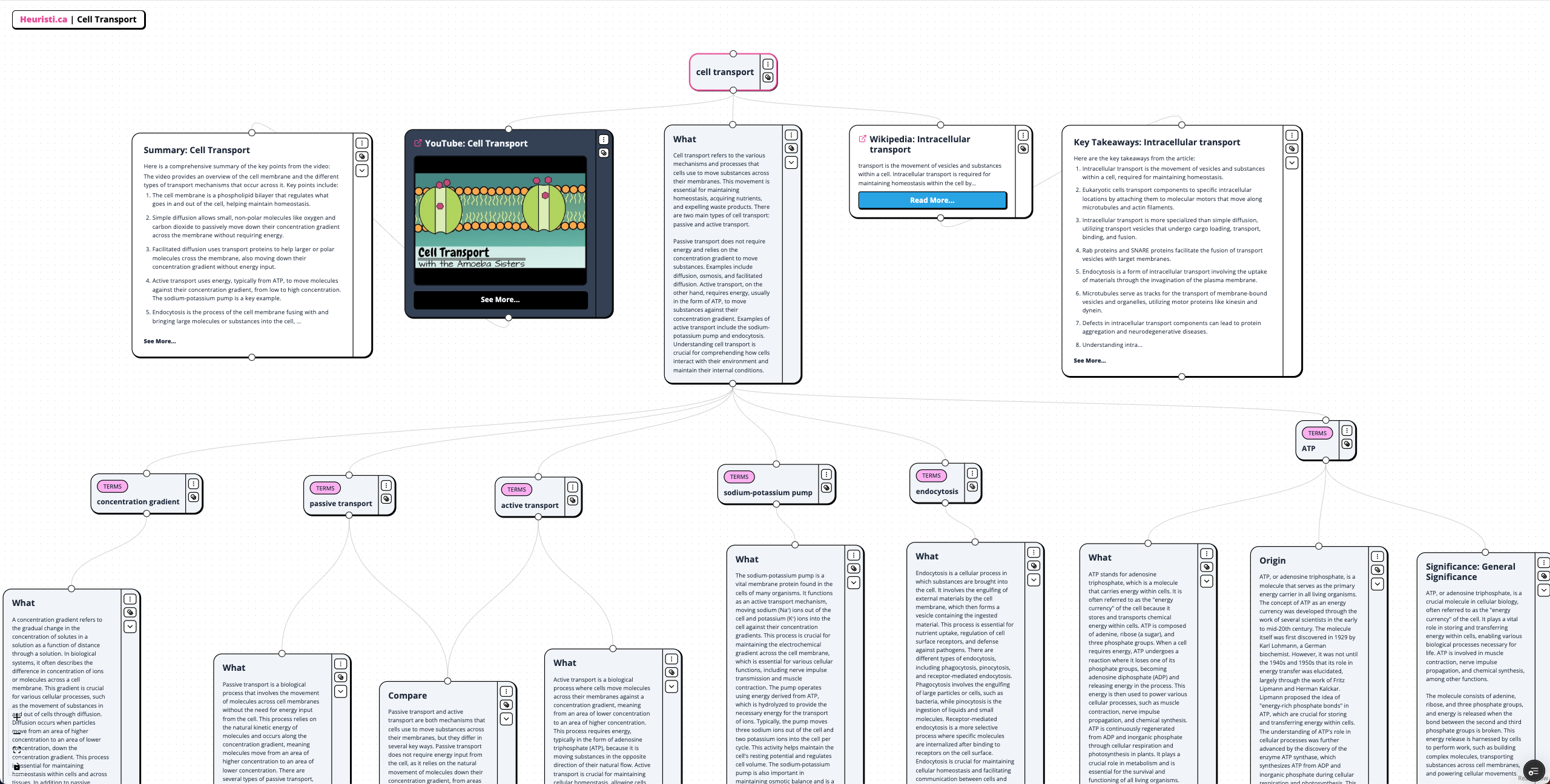Cell Transport Concept Map

Summary
Cell transport refers to the various mechanisms and processes that cells use to move substances across their membranes, which is essential for maintaining homeostasis, acquiring nutrients, and expelling waste products. There are two main types of cell transport: passive and active transport.
Passive Transport
Passive transport does not require energy and relies on the concentration gradient to move substances. It includes processes such as diffusion, osmosis, and facilitated diffusion. Diffusion is the movement of molecules from an area of higher concentration to an area of lower concentration. Facilitated diffusion uses transport proteins to assist in moving larger or polar molecules across the membrane. Osmosis specifically refers to the movement of water molecules through a selectively permeable membrane.
Active Transport
Active transport requires energy, typically in the form of ATP, to move substances against their concentration gradient. This process is crucial for maintaining cellular homeostasis and includes mechanisms such as the sodium-potassium pump and endocytosis. The sodium-potassium pump moves sodium ions out of the cell and potassium ions into the cell, maintaining the electrochemical gradient necessary for various cellular functions. Endocytosis involves the engulfing of external materials by the cell membrane to form vesicles, allowing for nutrient uptake and defense against pathogens.
Concentration Gradient
A concentration gradient is the gradual change in the concentration of solutes in a solution as a function of distance. It plays a critical role in both passive and active transport mechanisms, influencing how substances move in and out of cells. Understanding these gradients is essential for processes like osmosis, respiration, and photosynthesis.
Adenosine Triphosphate (ATP)
ATP is the primary energy carrier in cells, often referred to as the "energy currency." It is involved in various cellular processes, including muscle contraction and nerve impulse propagation. ATP is continuously regenerated from ADP and inorganic phosphate through cellular respiration and photosynthesis, highlighting its fundamental importance in biological systems.
Comparison of Passive and Active Transport
While both passive and active transport are essential for cellular function, they differ significantly. Passive transport relies on the natural movement of molecules down their concentration gradient without energy input, whereas active transport requires energy to move substances against their gradient. Understanding these mechanisms is vital for comprehending how cells interact with their environment and maintain their internal conditions.
Key Takeaways
Cell transport involves mechanisms for moving substances across cell membranes, essential for homeostasis, nutrient acquisition, and waste expulsion.
- There are two main types of cell transport: passive transport (no energy required) and active transport (energy required).
- Passive transport includes diffusion, osmosis, and facilitated diffusion, relying on concentration gradients.
- Active transport requires ATP to move substances against their concentration gradient, with examples like the sodium-potassium pump and endocytosis.
- A concentration gradient is the difference in solute concentration across a membrane, crucial for processes like diffusion and osmosis.
- ATP (adenosine triphosphate) is the primary energy carrier in cells, essential for various biological processes.
- The sodium-potassium pump maintains electrochemical gradients by moving sodium out and potassium into the cell, using ATP.
- Endocytosis is the process of bringing substances into the cell by engulfing them, with types including phagocytosis and pinocytosis.
- Understanding these transport mechanisms is vital for comprehending cellular functions and maintaining homeostasis.
Additional Concepts
Questions and Answers
What is cell transport?
What is passive transport?
What is active transport?
What is a concentration gradient?
What is ATP?
What is the sodium-potassium pump?
What is endocytosis?
How do passive and active transport compare?
Flashcards
What is cell transport?
Cell transport refers to the various mechanisms and processes that cells use to move substances across their membranes, essential for maintaining homeostasis, acquiring nutrients, and expelling waste products.
What are the two main types of cell transport?
The two main types of cell transport are passive transport, which does not require energy, and active transport, which requires energy to move substances against their concentration gradient.
What is passive transport?
Passive transport is a biological process that involves the movement of molecules across cell membranes without energy input, relying on the concentration gradient.
What is active transport?
Active transport is a biological process where cells move molecules against their concentration gradient, requiring energy, typically in the form of ATP.
What is a concentration gradient?
A concentration gradient refers to the gradual change in the concentration of solutes in a solution as a function of distance, crucial for processes like diffusion.
What is osmosis?
Osmosis is a specific type of passive transport that refers to the movement of water molecules through a selectively permeable membrane.
What role does ATP play in cellular processes?
ATP, or adenosine triphosphate, serves as the primary energy carrier in cells, providing energy for various biological processes such as muscle contraction and nerve impulse propagation.
What is the sodium-potassium pump?
The sodium-potassium pump is an active transport mechanism that moves sodium ions out of the cell and potassium ions into the cell, crucial for maintaining the electrochemical gradient.
What is endocytosis?
Endocytosis is a cellular process in which substances are brought into the cell by engulfing external materials, forming a vesicle containing the ingested material.